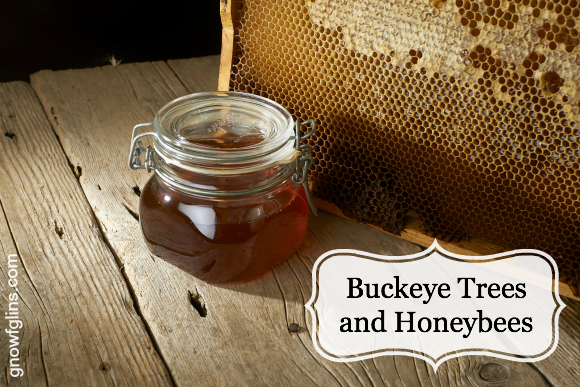
A couple of weeks ago I was in conversation about local foods and resources when I was offered Buckeye honey. I was told this honey is bottled up not far from me here in Northern California. I shrugged and agreed to try it. Having never heard of Buckeye honey, I asked what made it so special. It appears it is rather rare and pretty difficult to find.
The reason for this rarity? It kills the bees.
That’s right. The bees that make this honey? They die.
That little bit of information really caught me off guard. I must say I didn’t think it tasted like anything special, and I was a little put-off by the whole idea of killing bees on purpose. Why had I never heard of this before? I decided to do a little investigating.
A Poisonous Tree
The California Buckeye tree is extremely toxic to animals. The blossoms are poisonous to the honeybee, and it is certainly not something you want your livestock snacking on either. The honeybee is not native to California, which appears to be part of the problem. Native bees (and some others who pollinate the tree) are actually immune, but otherwise this tree is so toxic that very few animals even mess with it. According to an article in the San Francisco Chronicle, “California Indians ground the seeds to a powder that they used to stun fish for easy capture.” That’s some pretty potent stuff.
A few studies have been done on Buckeye trees and honeybees. It is considered a problem if a hive is within 3 miles of a Buckeye tree. If alternatives are available, honeybees will avoid the Buckeye tree, and exposure in small amounts is believed to not be a problem. But if there are no other sources of food, it quickly becomes a serious issue.
What Happens to the Bees?
When the honeybee uses the Buckeye tree as a source of food, it is not an instant poisoning. The bees take the pollen back to the hive where it slowly poisons the entire colony. The toxins cause the next generation of bees to be born deformed and wingless, and without wings they cannot source out food. Eventually, the queen bee stops laying eggs, and worker bees develop symptoms of paralysis. The end result is a destroyed colony. Rather morbid.
Bees are very loyal to their source of food, and whatever is closest to their hive. It is recommended that beekeepers move their hives away from Buckeye trees and to other sources of food. If the hives cannot be moved, the beekeeper can supplement the hive with sugar water (or the standard beekeeping mix of corn syrup) to dilute the Buckeye poison and help preserve the hive.
Buckeye Honey
It seems that it might not be the best idea to eat honey from a bee that was poisoned. If it bothered the bee, wouldn’t the honey bother the person eating it? Apparently not. Buckeye honey is entirely safe for human consumption.
Yet another completely amazing wonder of nature.
So What About This Local Buckeye Honey?
Armed with my new information, I decided to contact the local source of Buckeye honey directly. From what I could piece together, harvesting Buckeye honey had to include intentionally harming bee colonies, and I wasn’t sure I was very happy about that. When I checked their website, the only information I found said that this honey can only be produced during “rare environmental conditions“. That seemed pretty vague.
Giving the company the benefit of the doubt, I sent off an email asking for clarification and whether the information I had obtained was faulty. I was certainly happy with response I received. Here is part of the email:
“We collect honey from beekeepers throughout the US and occasionally are presented with intriguing varietal honeys – Buckeye is one that we never came across in 34 years! Most beekeepers know well enough to keep their bees far away from heavy concentrations of Buckeye during their bloom. However, this beekeeper was not well informed and lost many bees. However, he did produce some honey for us, which we offer to you as an extremely rare and unique varietal honey.”
There you have it. This explains why no matter how hard I googled, I could not come up with Buckeye Honey for sale anywhere else in the country. This batch was available only due to a rather large mistake on the part of the beekeeper.
I feel incredibly sorry for the beekeeper who had to learn about the effects of Buckeye trees in this way. I am also relieved to find that this is not an accepted practice among beekeepers here in California, or it would appear, elsewhere. And I am reminded that it is always a good idea to double check your facts. I am so glad that I did!
With luck the beekeeper was able to make up for some of his loss with the help of this company. If you want to purchase some, you can do so here: Z Specialty Food
How about you? Ever done your own research only to discover the facts lead you in a very different direction?
...without giving up the foods you love or spending all day in the kitchen!

2 free books:
Eat God's Way
Ditch the Standard American Diet, get healthier & happier, and save money on groceries...
We only recommend products and services we wholeheartedly endorse. This post may contain special links through which we earn a small commission if you make a purchase (though your price is the same).


I would boycott this honey.
That was my initial thought, too. I would love to hear more about why you came to this decision. Thanks for sharing!
If you boycott this honey you do double harm to the Bee Keeper who already lost his or her’s
bees. If they can at least send sell this honey , they can repopulate their hives.
I am really hoping that this companies willingness to purchase the honey helped the bee keeper to at least recover some of their loss.
No beekeeper would poision their bees on purpose with the seriousness of hive collapse happening all around…. So I wouldn’t boycott, it’s not necessary….but I do agree with you, Nichole, about supporting this farmer. We need to support all of our local beekeepers in a time like this.
A very interesting article… Thank you!
Only mildly on topic, this reminds me of a lovely essay by Scott Russell Sanders called Buckeye. He’s such a wonderful writer, and this piece is great article about loss and the Buckeye tree. Now I’ll have to go look it up again for a re-read. 😉
What a great recommendation! I started reading it tonight and will finish it tomorrow 🙂
This tree is highly toxic, not just to honeybees. There is already such a problem keeping bees alive and healthy. This article states that the bees will use alternative plants if available. I would immediately get rid of the toxic trees and plant healthy plants for bees as well as for animals. If it was toxic to your child would you keep it?
Buckeye is a beautiful native tree, and as mentioned in the article, native bees do fine with it. And it provides shade for cattle, deer, and other wildlife in CA foothills, growing without irrigation or special care. I would think that providing plenty of other tasty and non-poisonous trees and flowers would be a better alternative than removing all the buckeyes.
I actually agree with Marie and Nichole on this. I am so glad that Nichole got to the bottom of this issue by writing to the manufacturer and found out that this production was an exception (actually a mistake) rather than a common practice among local farmers. At this point since this one local farmer learned his lesson the hard way, I don’t believe in further penalizing him by leaving him with unsold inventory. In the future, bees should hopefully be safe since all the farmers know the right practices now.
Fine. It is decided. Enjoy your poisonous trees.
I also feel for the beekeeper. A 3 mile radius is a big area to know exactly what trees and flowers are in it. And you can’t go around asking neighbors to cut down their trees because of your bees. My 15 yr old son is a beekeeper and I can tell you it’s extremely heartbreaking when a hive dies. It’s not just about the money that was lost. There’s a responsibiltiy that we feel towards our bees that is the same as the responsibility we feel towards our chickens and our dog. Then there’s the responsibility that we feel towards the sustainability of bees in general. Thanks for sharing what you learned.
This was extremely interesting!! I had no idea. I’m a novice bee-keeper in southern CA. Shared this with my beekeeper friend and on my pages. 🙂 Thank you!
I have never heard of this. I live in Ohio & buckeye trees are everywhere here. We have honeybee hives & lots of honey here. Why doesnt it kill the bees here? [email protected]~~Please reply to my email address too. Thanks!
I sent an E-mail to Kim Flotum who is the Editor of Bee Culture Magazine in Medina, Ohio. He confirmed that the Buckeye trees in Ohio are NOT poisonous to Honeybees in Ohio. I feel with his Expertise, this should valid information. It must be a different strain in California. I was also concerned since I am a Beekeeper in Northwest Ohio and have some Buckeye trees near my hives.
I also read about this problem on the Internet. Hope this helps.
So…are the Buckeye trees in Ohio a non-poisonous variety, or the the Ohio bees simply have a tolerance for the toxin? I live in Iowa a wanted to plant some buckeyes, but am holding back until I learn if there is a non-poisonous variety I could use.
Hi Nichole:
Doing some research on Buckeye, I just happened to stumble across your most informative blog. Thank you for your kind words on our family biz, Z Specialty Food!
It’s true, we are the N. Calif. honey packer you contacted.
I have been a beekeeper for 45 years and in the honey biz since 1979.
The main function of a beekeeper is to manage the hives: this includes fostering their health and growth. It would be counter productive for beekeepers to intentionally harm their bees.
We have been working with some of our honey suppliers for many years, even now the next generation! Our suppliers are encouraged to keep separate any unique honeys for which we pay more. So far, our collection includes some 25 unique and tasty honeys from across the US. We are also starting to source internationally.
Ours is a compact, efficient company: we are three family members and two employees!
We do not ‘manufacture’; we carefully handle and package the honey bee’s amazing products.
If you are in the Woodland, CA area, please call to arrange a visit and we’ll show you around.
530 668 0660
Did you know that in the US we only produce 1/3 of the honey we consume?
The back story on the Buckeye honey producer:
He was a new beekeeper at the time and had not gotten the word about those delicious looking flowers.
He was very unhappy to only learn about Buckeye after seeing piles of dead bees. (I’ve attached an informative link from UC Davis w/fotos).
We’d never seen this honey before, and don’t expect to in the future.
In the meantime, we have ‘some’!
We always encourage new beekeepers to have a mentor. Books, videos and classes are not sufficient. Personally, I was fortunate to learn at the side of a master beekeeper.
I have been teaching my family about bees.
The California Buckeye is an interesting tree: grows along water courses, first to leaf out, first to drop leaves (in July), beautiful fragrant flowers.
http://ucanr.edu/blogs/blogcore/postdetail.cfm?postnum=13272
Those cone shaped flower stalks on the buckeye are just past prime bloom here in N. Calif.
I came across some “rare environmental circumstances” honey a few years ago. It was pink. Apparently the bees were kept near a strawberry farm and there had been a sudden glut of strawberries that year with some of them ripening on the vine and going to mush and the bees had been feasting on the mush.
They had just a couple of dozen jars of it.